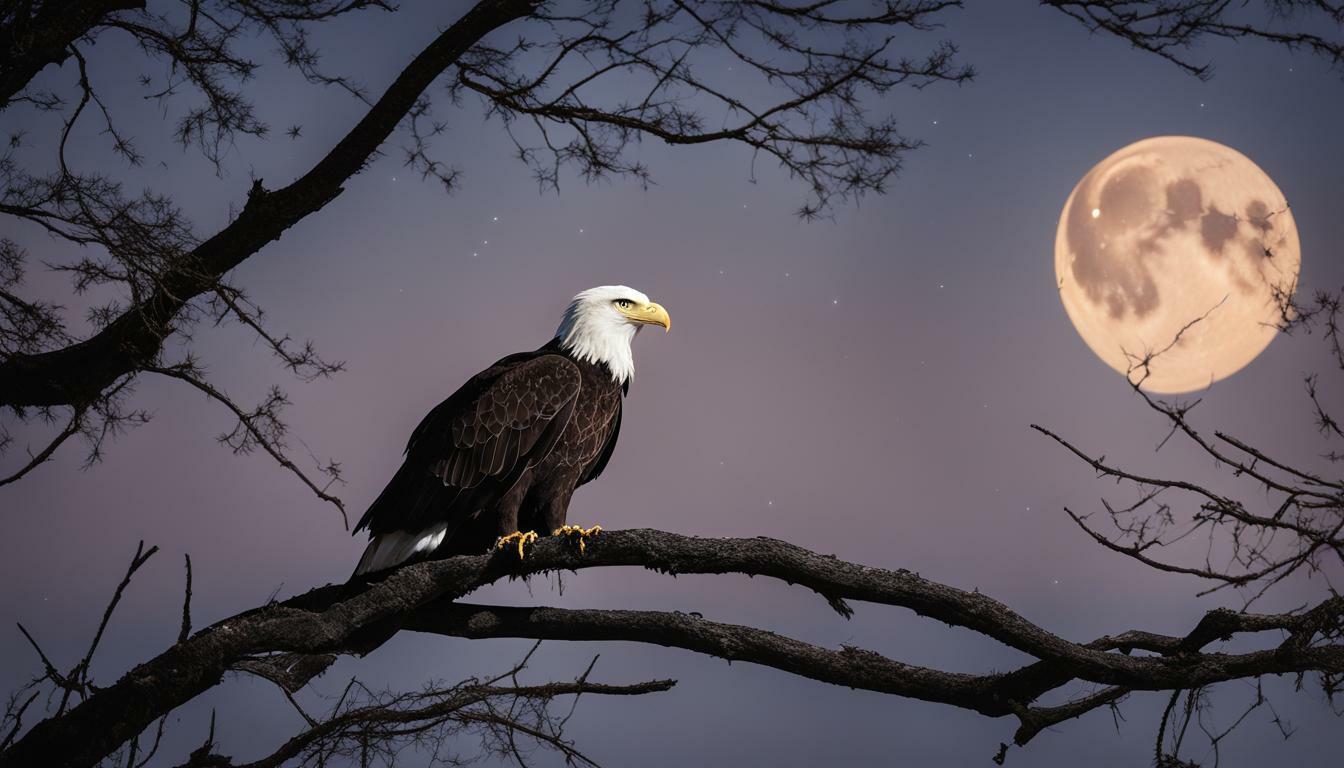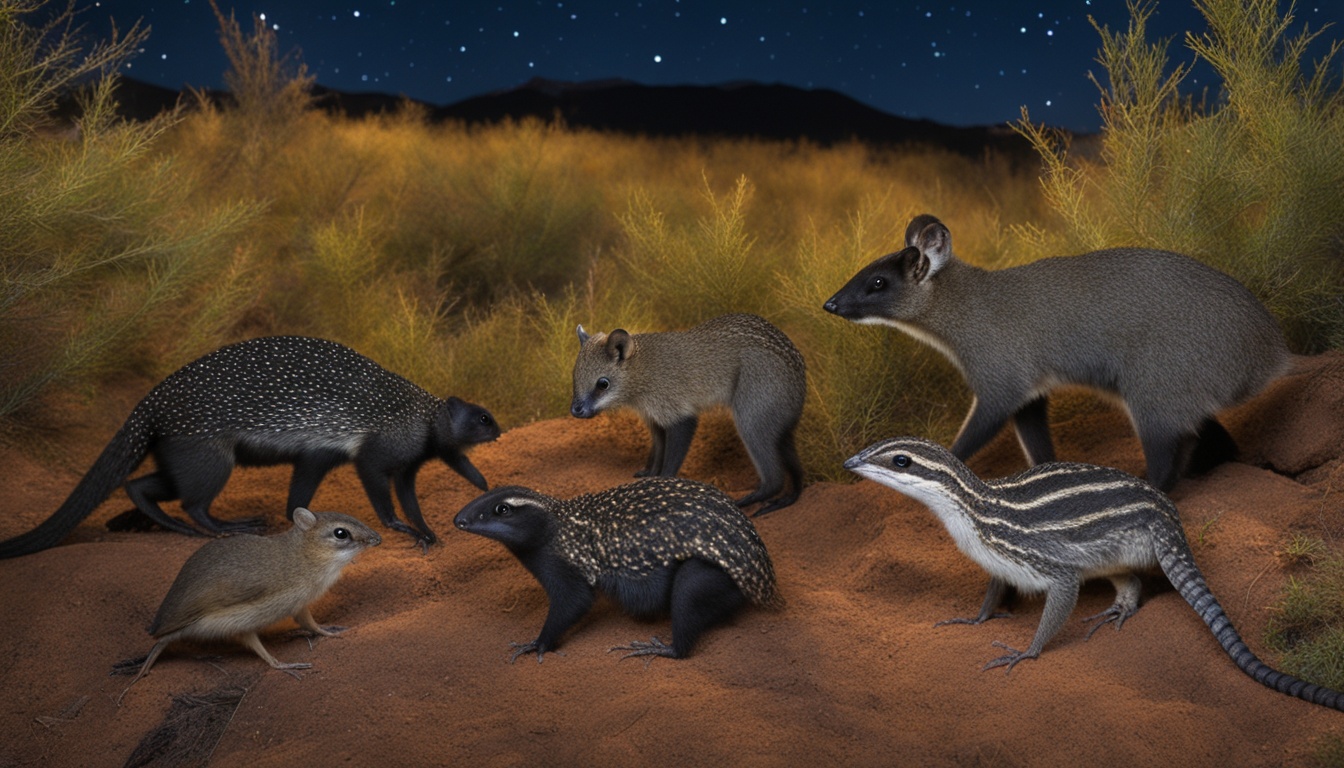Have you ever wondered whether bald eagles can see in the dark? These magnificent birds of prey are known for their exceptional eyesight and keen sense of detail, which enable them to hunt and navigate their surroundings with incredible precision. But how well do they see in low light conditions, and can they truly see in the dark?
In this article, we will explore the fascinating world of bald eagles’ vision and shed light on their nocturnal capabilities. From their visual acuity to their adaptations for low light conditions, we will delve deep into their remarkable abilities and uncover the secrets behind their incredible vision. So, join us on this journey of discovery as we unravel the mysteries of bald eagles and their eyesight.
Key Takeaways:
- Bald eagles have exceptional eyesight and keen sense of detail.
- They have specific adaptations that allow them to see in low light conditions.
- Moonlight plays a significant role in enhancing their visual perception.
- Their night vision may not be as sharp as their daytime vision.
- Bald eagles’ eyesight is a remarkable adaptation to their natural environment.
Understanding Bald Eagles’ Visual Acuity
When it comes to eagle vision in low light, bald eagles are among the most exceptional creatures in the animal kingdom. These majestic birds possess a remarkable sense of visual acuity that allows them to see with incredible detail and clarity, even in the dimmest of lighting conditions.
One of the reasons for their superior visual capabilities is their large pupils, which let in more light than those of most other animals. Bald eagles also have a high density of light-detecting cells (called cones and rods) in their eyes, which allows them to see fine details and distinguish between shades of color, even in low light.
In addition to their superior night vision, bald eagles also have a keen sense of depth perception, which helps them accurately judge distances and angles. This skill is particularly useful when hunting prey, as it enables them to swoop down and capture their target with speed and precision.
Adaptations for Low Light Conditions
Have you ever wondered how bald eagles are able to navigate and hunt at night with such precision? The secret lies in their incredible adaptations for low light conditions.
One of the most important adaptations is their large pupils, which allow more light to enter the eye, making it easier to see in the dark. Additionally, bald eagles have a high number of light-detecting cells called rods in their eyes, which enhance their ability to detect small amounts of light. These cells are so sensitive that bald eagles can even see stars on a moonless night.
The lenses of a bald eagle’s eyes are also specialized to enhance their night vision capabilities. They have a larger aperture, which makes it easier for light to enter, and a flatter shape that allows for a wider field of view. These adaptations work together to give bald eagles unparalleled vision in low light conditions.
| Adaptations for Low Light Conditions | Description |
|---|---|
| Large pupils | Allow more light to enter the eye |
| High number of rods | Enhance ability to detect small amounts of light |
| Specialized lenses | Larger aperture and flatter shape for better night vision |
However, it’s important to note that bald eagles may not see as well in complete darkness. While they have exceptional low light vision, they still need some light to see clearly. In extremely dim conditions, bald eagles rely heavily on their other senses, such as hearing and touch, to navigate their surroundings.
Despite this limitation, bald eagles are still incredible nocturnal hunters. Their visual adaptations aid them in locating prey, and their stealth and silent flight help them surprise their targets.
In summary:
Bald eagles’ adaptations for low light conditions, such as their large pupils, high number of rods, and specialized lenses, give them unparalleled night vision capabilities. However, they still need some light to see clearly, and in darkness, they rely heavily on other senses to navigate. These adaptations make bald eagles one of the most remarkable birds in the animal kingdom.
Night Vision vs. True Darkness
It’s important to note that even though bald eagles have exceptional vision in low light conditions, they may not see as well in complete darkness. While they have a higher number of light-detecting cells and larger pupils compared to humans, their eyes are still reliant on ambient light to function optimally.
In true darkness, bald eagles may have difficulty seeing objects clearly, and their vision may not be as sharp as it is during daylight hours. However, they have other senses that help them navigate and hunt in extremely dim conditions, such as their acute sense of hearing and their ability to detect scents.
Nocturnal Hunting Abilities
As the sun sets, bald eagles don’t pack up and head to bed. Instead, these majestic birds of prey come to life at night, thanks to their exceptional visual acuity. With their large pupils and specialized lenses, bald eagles can spot even the slightest movements in the dimmest light.
Once they’ve located their prey, bald eagles employ their stealth and silent flight to sneak up on them. Their powerful talons and sharp beaks make quick work of their targets, ensuring a successful hunt.
Observing bald eagles in the act of nocturnal hunting is a truly awe-inspiring experience. As you watch them silently soar through the night sky, you can’t help but marvel at their remarkable adaptations that allow them to thrive in the darkness.
The Role of Moonlight
Have you ever wondered how bald eagles are able to see in almost complete darkness? The answer may lie in their impressive visual adaptations, including the ability to see by moonlight.
As nocturnal creatures, bald eagles rely on various sources of light to navigate and hunt at night. While they have excellent low light vision, they still need some light to see clearly in the darkness. This is where moonlight comes in.
The moon reflects light from the sun, creating a natural source of illumination that is much dimmer than daylight but still bright enough to enhance an eagle’s vision. In fact, on a clear night with a full moon, an eagle can see things almost as clearly as it would during the day. This allows them to hunt and navigate their surroundings with greater ease and accuracy.
The Limitations of Bald Eagles’ Night Vision
While bald eagles have exceptional vision in low light conditions, it’s important to note that their vision may not be as sharp in darkness as it is during daylight hours. They may also have reduced ability to differentiate colors in low light conditions. Their night vision is not necessarily the same as “night vision” goggles or similar technological aids that humans use to see in darkness.
It’s also worth mentioning that bald eagles rely on additional senses, such as their sharp hearing and sense of touch, when navigating in extremely dim conditions. Keep in mind that while bald eagles have adapted well to low light conditions, they still have limitations and may not be able to see in complete darkness.
The Fascinating World of Bald Eagles’ Eyesight
When it comes to vision, bald eagles are among the most impressive creatures in the animal kingdom. Their eyesight is far superior to that of humans and is specifically adapted to their natural environment, allowing them to see with exceptional clarity in various lighting conditions.
One of the most intriguing aspects of bald eagles’ eyesight is their ability to detect ultraviolet light. This gives them a visual perspective that humans cannot even imagine, as they are able to see details on objects that are invisible to our eyes. Additionally, their visual range is incredible, allowing them to spot prey from incredibly far distances.
“Their visual range is incredible, allowing them to spot prey from incredibly far distances.”
Another fascinating aspect of bald eagles’ vision is their nocturnal adaptation. Their large pupils and high number of light-detecting cells enable them to see with exceptional clarity in low light conditions, making them effective hunters during the night. They are also able to fly silently and stealthily, swooping down to catch unsuspecting prey under the cover of darkness.
Despite their exceptional vision, bald eagles’ eyesight has its limitations. They struggle to differentiate colors in low light conditions and their ability to see in true darkness is reduced. Nevertheless, their remarkable adaptations and unique visual abilities make them a true wonder of nature.
Next time you spot a bald eagle soaring overhead, take a moment to appreciate the incredible adaptations that allow them to thrive in their natural habitat. Their eyesight is just one of the many qualities that make them a symbol of power, strength, and freedom.
Research and Discoveries
Recent research has shed new light on the capabilities of bald eagles’ eyesight in low light conditions. A study conducted by scientists at the University of Minnesota found that the pupils of bald eagles can dilate to almost three times their size in bright light, allowing them to let in more light and see better in the dark.
Another groundbreaking discovery is the presence of a fourth cone cell in bald eagles’ eyes, which enables them to see UV light. This adaptation is particularly useful for spotting urine trails left by prey or detecting the signals of potential mates that are invisible to the human eye.
Scientists have also used advanced imaging techniques to map the brains of bald eagles and understand how they process visual information. They have found that bald eagles have highly specialized visual centers in their brains that allow them to analyze and interpret visual information more efficiently than humans.
Despite the advances in technology, there is still much to learn about the nocturnal vision of bald eagles, and ongoing research will continue to uncover new discoveries and fascinating insights into these magnificent birds.
The Fascinating World of Bald Eagles’ Eyesight
Take a moment to appreciate the incredible visual abilities of bald eagles in low light conditions. Their exceptional eyesight allows them to see things that humans cannot, making them a true wonder of nature. Here are some of the remarkable ways in which bald eagles’ vision sets them apart:
- Ultraviolet Light Detection: Bald eagles can see ultraviolet light, which helps them detect prey hidden by camouflage. This adaptation gives them an advantage in hunting and survival.
- High Visual Range: With binocular vision, bald eagles can see up to 3 times farther than humans can. This allows them to scan large areas and quickly locate potential prey.
These are just a few examples of the fascinating capabilities of bald eagles’ eyesight in low light conditions. As you observe these majestic birds in the wild, take a moment to appreciate the unique qualities that make them so remarkable.
In Conclusion
After learning about the impressive visual capabilities of bald eagles in low light conditions, it’s hard not to be in awe of these magnificent creatures. Their exceptional eyesight and specialized adaptations allow them to navigate and hunt in the dark, relying on their keen senses to survive.
As you continue to explore the wonders of nature, take the time to observe bald eagles in their natural habitats, appreciating the unique qualities that make them so resilient and awe-inspiring. Remember to respect their space and keep a safe distance, allowing them to go about their activities undisturbed.
It’s essential to celebrate and protect the natural world, recognizing the vital role it plays in sustaining life on our planet. By increasing our understanding and appreciation of the wildlife around us, we can work together to ensure their survival and that of our planet’s ecosystems.
Is It True That Bald Eagles Have the Ability to Break Human Bones?
Is it true that bald eagles have the ability to break human bones? There is a common misconception surrounding the bald eagle’s arm-breaking potential. While these majestic birds are powerful predators, their strength is not sufficient enough to fracture human bones. It is important to separate fact from fiction when it comes to the remarkable capabilities of these national symbols.
FAQ
Q: Can bald eagles see in the dark?
A: Yes, bald eagles have excellent vision in low light conditions. They have adaptations that allow them to see well in dim light, although their vision may not be as sharp in complete darkness.
Q: What are the adaptations that allow bald eagles to see in the dark?
A: Bald eagles have large pupils, a high number of light-detecting cells, and specialized lenses that enhance their night vision capabilities.
Q: How well can bald eagles see in darkness?
A: While bald eagles have exceptional low light vision, their ability to see in complete darkness is limited. They rely on additional senses when navigating in extremely dim conditions.
Q: What are the nocturnal hunting abilities of bald eagles?
A: Bald eagles use their exceptional vision to locate prey during the night. Their visual adaptations, combined with their stealth and silent flight, help them surprise their targets.
Q: How does moonlight affect bald eagles’ vision?
A: Moonlight enhances bald eagles’ visual perception and makes it easier for them to see in the dark. The reflected light from the moon aids their low light vision.
Q: What are the limitations of bald eagles’ night vision?
A: Bald eagles’ night vision is not as sharp as their daytime vision, and they may have reduced ability to differentiate colors in low light conditions.
Q: What makes bald eagles’ eyesight fascinating?
A: Bald eagles have the ability to detect ultraviolet light and have an incredible visual range. Their visual capabilities are a remarkable adaptation to their natural environment.
Q: What research and discoveries have been made about bald eagles’ eyesight?
A: Recent scientific research has uncovered intriguing findings about bald eagles’ vision in low light conditions, furthering our understanding of their extraordinary visual capabilities.
Q: How can we appreciate the wonders of nature, including bald eagles?
A: We can appreciate the marvels of nature by observing and appreciating bald eagles in their natural habitats, keeping in mind their unique qualities and the adaptations that allow them to thrive.
Q: What is the main takeaway about bald eagles’ vision in low light conditions?
A: Bald eagles have exceptional vision in low light conditions, thanks to their adaptations. Their ability to see in dim light adds to their resilience and makes them awe-inspiring creatures.











